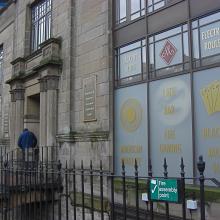
The Genting Casino (owner of Maxims) has applied for listed building consent to replace signs and erect lights on the exterior of its Ecclesiastical Category A-listed 5B York Place premises (Ref. 11/03445/LBC). New LED uplights to illuminate the windows are proposed.
This somewhat theatrical, slightly peculiar building was built as St George's Episcopal Church between 1792 and 1794 to designs by James Adam. Gifford et al. say it is virtually a copy of George Dance's St Bartholomew's-the-Less in London (replaced in 1834).
The display windows at the front, opaquely advertising the delights within, are not original and date from as recently as 1934 when the property was already in commercial use. Furnishings from the old church – including a brass lectern, Sir Walter Scott's box pew, and a hexagonal, white marble font – are now over the road in St Paul's and St George's.
You can see a print of the building in its original context at rcahms.
[img_assist|nid=2524|title=|desc=|link=node|align=middle|width=200|height=149]
******
To widespread disappointment but nobody's particular surprise, permission has been granted for alterations at 28 Howe Street which will allow Sainsbury's to open a branch there (Ref. 11/02841/FUL).
The thinking behind this unwelcome decision can be found in our coverage last week (Breaking news, 6.12.11).
******
To widespread disappointment but nobody's particular surprise, permssion has been granted for Greggs of Scotland to go ahead with its refit of Category B-listed premises at 27 Broughton Street (Ref. 11/03105/FUL).
Planners found that 'The proposals comply with the development plan and relevant non-statutory guidelines and there is no significant impact on character and appearance, road safety or neighbouring residential amenity'. Of course, it was not residential but commercial amenity that most locals were worried about.
The Decision Notice (available at the foot of this page) notes that there were 3 letters of objection, which between them raised only 1 'material' consideration, namely road safety. However, officials did not think the point sufficiently valid to put the brakes on the proposal.
If locals are serious about preserving the commercial futures of small, independent retailers on Broughton and Howe Streets, the simplest and most effective thing we can do is to use them, not their larger competitors.
******
[img_assist|nid=2522|title=|desc=|link=node|align=right|width=200|height=150]Planning permission has been granted to TIE for the demolition of a 1970s public toilet block at 3, 5–7 Cathedral Lane (Ref. 11/03105/FUL). They are to be replaced by 2 (partly tram-related) electricity substations.
However, before the project can go ahead, a Conservation Area Consent must be received. This is still under consideration (Ref. 11/03129/CON).
The City Archaeologist thought it unlikely anything of any archaeological value remains in the ground, where a tenement stood until clearance in the 1960s.
Planning officials considered that 'The proposals enhance the character and appearance of the conservation area, and do not harm the universal values of the World Heritage Site, or the setting of the adjacent listed buildings'.
Spurtle understands these and other points made in favour of the new structure, but still wonders about the loss of a conveniently-sited convenience. Where are members of the public now expected to go? Surely, no public toilet – however unlovely and misused – should be removed without another being provided in lieu.
******
[img_assist|nid=2523|title=|desc=|link=node|align=right|width=200|height=114]Plans to convert a former gardener's cottage into a restaurant at 1 Royal Terrace Gardens (Ref. 11/03351/LBC) have been given the go-ahead.
Known rather pretentiously as Royal Terrace Gardens House, the building was designed by William Playfair in 1836.
The Cockburn Association welcomed the change of use, which would help to preserve the listed structure. However, it objected to proposed alterations to the interior proportions of the building which – it argued – would impact negatively on the building's character.
A change of use for the property – from residential to café/restaurant – was first granted in 2009, partly because its poor state of repair offered inadequate accommodation. Its relative isolation also rendered it prone to vandalism and was a potential security risk to residents.
No copy of the Council's latest Decision Notice – giving reasons for its approval – is yet available online.